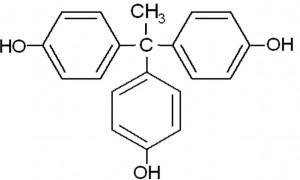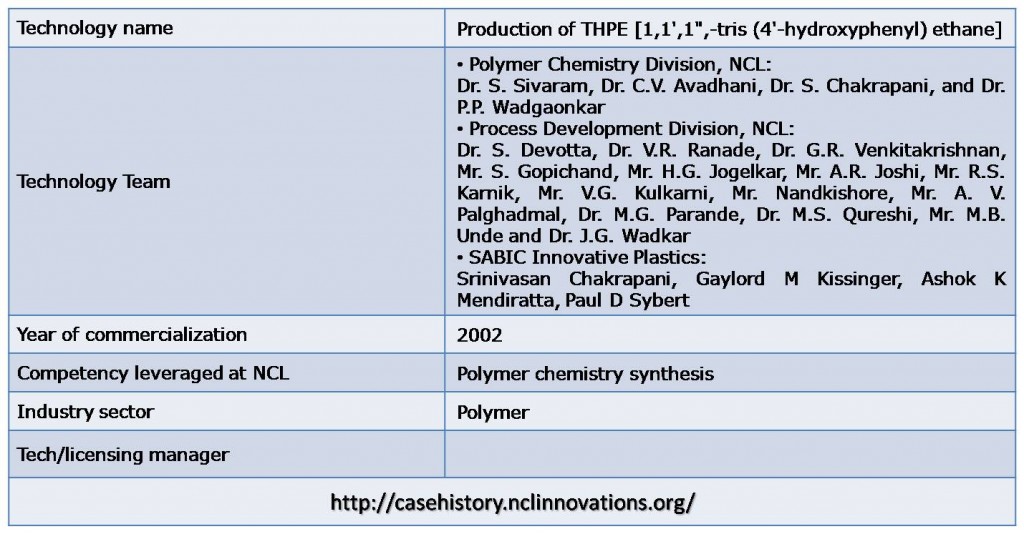The THPE story: A new route and a new supplier
August 14, 2012 by Editor
*Draft under discussion for finalization*
In 1991, Dr. Mendiratta from GE casually mentioned to his friend Dr. Sivaram from NCL that GE needed an alternate route to produce THPE [1,1′,1″,-tris (4′-hydroxyphenyl) ethane], a cross linking or branching agent in polymer applications. 11 years later, it became a novel, patented, industrial scale manufacturing technology which created a toll manufacturer for THPE in India and a valuable collaboration between GE and NCL. The NCL team also bagged the CSIR Technology Award for 2003 for this new production route for THPE.
*****

Click image to watch animated process.
[Source : http://www.bpf.co.uk/Data/Image/Extrusion%20Blow
%20Moulding.swf]
Plastic is omnipresent in our lives these days. Polycarbonates are a particular group of thermoplastic polymers. They are easily worked, molded, and thermoformed. They also have uniquely high impact strength. Because of these properties, polycarbonates find many applications, including the manufacture of drinking bottles, glasses and food containers. These types of hollow plastic parts are manufactured via a process known as Blow molding (also known as blow moulding or blow forming). The process begins with melting down the plastic and forming it into a parison or preform. The parison is a tube-like piece of plastic with a hole in one end in which compressed air can pass through. This parison is clamped into a mold and air is pumped into it. The air pressure pushes the plastic out to match the mold. Once the plastic has cooled and hardened the mold opens up and the part is ejected. An animation of this process can be seen by clicking on the picture at the right.
Sizable amount of molten plastic is needed for manufacture of large containers, like the 20 liter containers of packaged drinking water. When a parison is formed out of significant amount of molten plastic, it can collapse under the effect of gravity and its own weight. If the pipe-like shape is not withheld, blow moulding cannot take place. It is, therefore, essential that the molten plastic has enough structural integrity. Branched polycarbonates are the answer to this dilemma! The branched structure of these polymers gives enough strength to their molten mass to hold the pipe-like shape even at higher weights. THPE [1,1′,1″,-tris (4′-hydroxyphenyl) ethane] is used as a cross linking or branching agent in various polymer applications. The branching agents employed in these applications are tri-functional or higher molecules that are incorporated within a linear aromatic carbonate polymer chain. They then have a functional group left free for further reaction which provides the branched structure. Branched polycarbonates derived from THPE are high molecular weight thermoplastics. These hyper-branched materials are ideal for blow moulding large structured containers, like 20 liter containers of packaged drinking water.
THPE has, therefore, been an essential component of the plastic industry for decades. During and before the 1990s, Hoechst Celanese in the US had a monopoly in THPE manufacture. They held the patent for this process and produced THPE at their plant in Salisbury, NC. Anyone in the whole world had to buy THPE from them if they needed it! This monopoly, of course, gave Hoechst Celanese Corp. the privilege of charging as high a price as they wished for the product. GE Plastics (that became SABIC Innovative Plastics in 2007) was one of the principal customers of Hoechst Celanese and they weren’t happy with the situation. GE was on a lookout for an alternative supplier and was also exploring the option of producing THPE themselves.
Dr. Ashok Mendiratta, working at GE’s manufacturing site at Mt. Vernon, IN at the time, was on a visit home to India in 1991. While he came to Pune to meet his sister, he also thought of catching up with an old friend, Dr. S. Sivaram, then a scientist at the Polymer Chemistry Division at NCL. During their chat, Dr. Mendiratta casually mentioned to Dr. Sivaram that GE was looking for an alternate route to produce THPE, without infringing on the Hoechst Celanese patent. After the former returned to the US, a research contract was signed in 1992 between the two for developing an alternate process for manufacture of THPE. When the research started showing promising results, around 1993-94, the more people from the Mt. Vernon site got interested in the process. Dr. Sivaram visited the site in 1994 to present the progress and results of the said research.
Dr. Raj Varadarajan, working at the Schenectady R&D site for GE had no idea of what was going on at the Mt. Vernon site. However, he heard of NCL and Dr. R. A. Mashelkar, the then Director of NCL, through his own sources. He visited NCL in 1994 and requested to meet the Director. Since Dr. Mashelkar knew of the work Dr. Sivaram was doing with the GE Mt. Vernon site, he invited the latter to the meeting with Dr. Varadarajan. In this meeting, Dr. Varadarajan learnt of NCL’s existent ties with GE in form of the research contract between Drs. Mendiratta and Sivaram. When he went back to the US, Dr. Varadarajan investigated further into the nature of this research and realized that it would be of GE’s benefit to expand this research contract into a broader collaboration with NCL. An alliance between NCL and GE was, thus, formed and signed in 1996.
By this time, the original research into an alternate path for production of THPE had concluded with a successful, lab-scale, pilot run at NCL’s Polymer Chemistry Division. The next important steps now were to scale up the process for industrial scale manufacture and file a patent application for the same. The first task for Dr. Sivaram was to find a supplier who would supply several liters of 4-HAP (4-hydroxy acetophenone), the raw material for producing THPE. Most of his searches ended at the Hoechst Celanese’s Salisbury plant! Of course, he needed to look for an alternative. His quest ended with Excel Industries, an agrochemicals manufacturer from Mumbai. Excel Industries Limited was founded in 1941 by Mr. C. C. Shroff in form of a kitchen laboratory. Over the years, Excel came to be known as an industry leader in the area of agro-chemicals and agro-chemical intermediates. 4-HAP was used in the production of agrochemicals and hence, Excel produced its own 4-HAP on industrial scale. When Dr. Sivaram came across a manufacturer who produced the raw material and had the capability to produce THPE on industrial scale as well, an idea was sparked in his mind. Why not get Excel Industries to manufacture THPE on industrial scale in India? Why do all the research and trial-error here and then transfer the knowhow to another country?
 When Dr. Sivaram approached Excel’s Mr. Shroff with the idea, he showed readiness to take up the task. They were approved by GE for safety and environmental regulations, an approval any vendor for GE had to receive. The THPE manufacture was successfully commercialized in India in 2002 and the NCL team bagged the CSIR Technology Award in 2003 for this new production route. The process was patented under both, a US (1999) and an Indian patent (2003) and licensed to GE. The US patent made sure that GE could import the Indian manufactured THPE without infringing on Hoechst Celanese’s patent. In 1991, Dr. Mendiratta from GE casually mentioned to his friend Dr. Sivaram from NCL that GE needed an alternate route to produce THPE. 11 years later, it became a novel, patented, industrial scale manufacturing technology which created a toll manufacturer for THPE in India and a valuable collaboration between GE and NCL.
When Dr. Sivaram approached Excel’s Mr. Shroff with the idea, he showed readiness to take up the task. They were approved by GE for safety and environmental regulations, an approval any vendor for GE had to receive. The THPE manufacture was successfully commercialized in India in 2002 and the NCL team bagged the CSIR Technology Award in 2003 for this new production route. The process was patented under both, a US (1999) and an Indian patent (2003) and licensed to GE. The US patent made sure that GE could import the Indian manufactured THPE without infringing on Hoechst Celanese’s patent. In 1991, Dr. Mendiratta from GE casually mentioned to his friend Dr. Sivaram from NCL that GE needed an alternate route to produce THPE. 11 years later, it became a novel, patented, industrial scale manufacturing technology which created a toll manufacturer for THPE in India and a valuable collaboration between GE and NCL.
References:
- Interview with Dr. S. Sivaram, CSIR Bhatnagar Fellow, NCL
- LinkedIn Group : Unique products, unique demand
- NCL website : Achievements – Patents
- NCL’s Intellectual Property Group website : IPMS v02 patent database
- NCL’s Intellectual Property Group website : IPMS v02 patent database
- NCL’s IPG – IPMS database : The US patent
- Patentbuddy.com : The US patent




